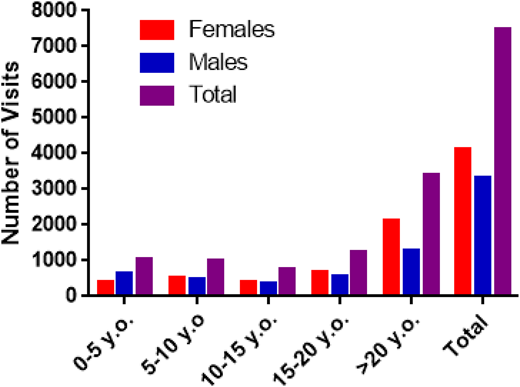Introduction
The Republic of Congo (RC) (Figure 1) has one of highest prevalence rates of sickle cell trait (SCT) in the world. The prevalence of sickle cell disease (SCD) is estimated to be at least 1.5% with an expected nationwide SCD patient population of 70 000. RC has no established national newborn screening program. Adult sickle cell screening is offered at the University of Brazzaville, but no dedicated clinical care program is available. A capacity-building initiative between Howard University and RC was developed in 2016 with the goal of establishing a National Sickle Cell Center in Brazzaville that would offer comprehensive outpatient and inpatient care. Additional goals were to estimate the need for the service in RC, to establish the prevalence of SCT and SCD in RC, and to plan future research projects to study SCD complications such as pain and chronic kidney disease.
Hypotheses
A national sickle cell clinical care program can be established in a resource-poor environment.
RC has the highest world prevalence of SCT.
Results
Capacity building
The National Sickle Cell Center opened in 2016.
The Center began provisional operations from 2016 to 2018 (Figure 2).
The hospital is open daily from 6 am to 7 pm.
Patients are triaged in an admission suite.
Red cell exchange transfusion is available (Figure 3).
Analgesics including opioids are available.
Basic biochemistries are available.
Chest X-ray, abdominal ultrasound, and transcranial Doppler ultrasound are the available imaging modalities.
Physical and speech therapy are offered.
Sickle cell diagnostic testing is offered.
Services offered at the National SCD Center and imaging and cardiac testing (February 2016-June 2018).
Services offered at the National SCD Center and imaging and cardiac testing (February 2016-June 2018).
Conclusions and perspective
A collaborative partnership was established between Howard University and the National Sickle Cell Disease Center, Brazzaville, Republic of Congo.
The Center provides basic hemoglobinopathy diagnostics and treatment for 8000 patients.
Imaging tests were performed for 266 SCD patients.
Future plans include establishing advanced diagnostics (high-performance liquid chromatography or isoelectric focusing) and implementing research objectives (prevalence of SCT and SCD and epidemiology of SCD complications in the RC).
Acknowledgements
This work was supported by Foundation Congo Assistance, Ministere de a Sante et de la Population, by Center National de Reference de la Drepanocytose “Antoinette Sassou Nguesso,” by Howard University, and by National Institutes of Health, National Heart, Lung, and Blood Institute grants 1P50HL118006 and 1R01HL125005.
The content does not represent the official views of the National Institutes of Health.
Authorship
Conflict-of-interest disclosure: S.N. received research funding from the National Institute of Allergy and Infectious Diseases, the National Heart, Lung, and Blood Institute, and the National Institute on Minority Health and Health Disparities of the National Institutes of Health. J.G.T.VI received research funding from Pfizer and the National Heart, Lung, and Blood Institute. The remaining authors declare no competing financial interests.
Correspondence: Alexis Elira Dokekias, The National Sickle Cell Disease Center, Brazzaville, Republic of Congo; e-mail: elira.dokekia660@gmail.com.



